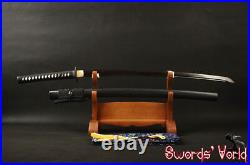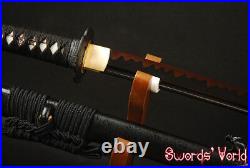Iron Tsuba Japanese Katana Sword Electroplating Clay Tempered 1095 Carbon Steel —













Iron Tsuba Japanese Katana Sword Electroplating Clay Tempered 1095 Carbon Steel. Overall Length: 40.6 inch /103 cm Tsuba: Iron. Blade Length: 27.5 inch / 70 cm Menuki: Alloy. Handle Length: 10.24 inch / 26cm Habaki: Brass. Blade Width: 1.26 inch / 3.2cm Seppa: Top grade brass. Blade Thickness: 0.28inch / 0.7cm RayskinWhite real rayskin. Blade material: 1095 carbon steel Bo-hi: Yes. Craft: Electroplating, Clay tempered Tang: Full tang. SayaMatt Black Wood saya Ito & Sageo: Silk sageo. Katana -One of Japanese Quintessence, is the product of worldwide unique specific forging craft. Obedience to Japanese traditional work craft, we produce katana and swords in different series, different style, and different usage. This KATANA is 100% hand-forged and hand-sharpened according to the Japanese traditional forging methods. Our differentially hardened carbon steel blades have been heat-treated, sharpened, and well-balanced. The blade is constructed from high quality carbon steel, carefully hand beaten into shape, forged, quenched before being polished by hand to a mirror sheen. Before being quenched, a special clay mixture can be applied onto the blade to harden the edge and obtain different hardness on the blade. And would be applied to the edge of the blade before being quenched. During quenching, a chemical reaction between the clay mixture and the hot steel occurs during the sudden temperature drop and carbon is fed into the blade in high amounts, creating an extremely tough edge. A clay hardened blade can only be quenched in water, thus increasing the defect rate even more. Another way for clay tempering is to apply clay along the blade but let edge exposed. Thus, while quenching the blade into water, the uncoverd edge will cool down suddenly, but the rest of blade will cool down slowly. Such differential temperature change results in the different hardness of the blade. So the edge is tough enough to cut, where the back of blade is soft/flexible enough to absorb the impact during cutting. Such quenching process usually will leave beautiful wavy tempered line on the blade, as known as “homon” in Japanese swords term. After quenching, the sword will be quite tough and brittle, with little flexibility. To overcome this, the blade would undergo a tempering process. The blade would be reheated to a certain temperature degree then allowed to cool naturally. The blade would be slightly less tough afterward but have a greater degree of flexibility – the art would be to perfectly balance the blade for toughness, sharpness and flexibility. While it is common to find swords which have a rat tail tang (two pieces welded together), a thin tang or even no tang at all, all of our Japanese swords have a thick tang running from the blade to the full length of the handle. DESIGN YOUR UNIQUE SWORD. Only after we confirm, can the changes be done. Ito & Sageo Cord. International Buyers – Please Note. Please contact with us before you leave feedback. We will try our best to solve the problem for you, thank you. Sometimes, you may not get our reply immediately due to the time difference among each country. However, please be assured that we’ll strive to reply you as soon as possible once we got your messages. This item is in the category “Collectibles\Knives, Swords & Blades\Swords & Sabers\Asian\Japanese”. The seller is “lqshijian2014″ and is located in this country: CN. This item can be shipped worldwide.
- Type: katana
- Handle Material: Wood
- Tang: Full
- Edge: Single, Curved
- Authenticity: Original
- Blade Material: Carbon Steel
- Handedness: Double-Handed
- Dexterity: Right-Handed
- Theme: Samurai
- Country/Region of Manufacture: China
- Color: Black
- Brand: Swords’ World

Categorised as: iron
Comments are disabled on this post